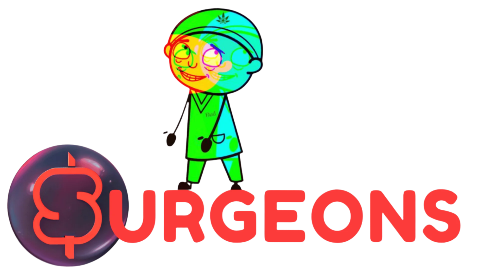Surgeons Online Cannabinoid Academy
A List & Explanation Of Side Effects: Drug Interactions & More
Introduction
As CBD and other cannabinoids gain popularity for their therapeutic benefits, many people are incorporating them into their wellness routines alongside traditional medications. While cannabinoids are generally safe, they can interact with certain drugs, altering their effects and potentially causing adverse reactions. Understanding these interactions is crucial for ensuring safe and effective use. This guide provides a comprehensive overview of drug interactions with CBD and other cannabinoids, helping you make informed decisions about your health.
How CBD and Cannabinoids Interact with Medications
CBD and other cannabinoids interact with the body through the endocannabinoid system (ECS) and the liver’s CYP450 enzyme system. The CYP450 enzymes are responsible for metabolizing many medications. Cannabinoids like CBD can inhibit these enzymes, slowing drug metabolism and leading to higher drug concentrations in the bloodstream. Alternatively, cannabinoids can sometimes speed up metabolism, reducing a drug's efficacy.
For example:
- Inhibition: Cannabinoids slow down the breakdown of drugs like blood thinners, increasing their potency and risk of side effects.
- Induction: Cannabinoids may accelerate the metabolism of certain drugs, reducing their effectiveness.
Common Medications Affected by Cannabinoids
Some medications are more likely to interact with CBD and other cannabinoids. Here are key categories and examples:
-
Blood Thinners
- Examples: Warfarin, clopidogrel
- Effect: Increased bleeding risk due to heightened potency.
-
Antidepressants
- Examples: SSRIs (e.g., sertraline), tricyclic antidepressants
- Effect: Altered drug levels may intensify side effects like drowsiness.
-
Antiepileptic Drugs
- Examples: Clobazam, valproate
- Effect: Increased sedative effects or reduced drug efficacy.
-
Sedatives and Sleep Aids
- Examples: Benzodiazepines (e.g., diazepam), zolpidem
- Effect: Amplified drowsiness or respiratory depression.
-
Immunosuppressants
- Examples: Tacrolimus, cyclosporine
- Effect: Altered drug metabolism may compromise immune response.
-
Pain Relievers
- Examples: Opioids (e.g., oxycodone), NSAIDs (e.g., ibuprofen)
- Effect: Increased risk of sedation or gastrointestinal side effects.
-
Heart Medications
- Examples: Beta-blockers (e.g., metoprolol), calcium channel blockers
- Effect: Blood pressure fluctuations or increased side effects.
Potential Risks and Adverse Effects
When cannabinoids interact with medications, users may experience:
- Drowsiness: Amplified sedative effects can impair cognitive and physical performance.
- Nausea or Vomiting: Altered metabolism may exacerbate gastrointestinal side effects.
- Lightheadedness: Cannabinoid interactions may cause blood pressure changes.
- Toxicity Risks: Prolonged drug action can increase the likelihood of adverse reactions.
Monitoring for these symptoms is essential, particularly when starting or adjusting cannabinoid use.
Managing Cannabinoid Use with Medications
To minimize risks:
- Consult a Healthcare Provider: Discuss all supplements and medications with your doctor.
- Start Low and Go Slow: Begin with a small dose of CBD or cannabinoids and gradually adjust.
- Time Your Intake: Separate cannabinoid and medication dosages to reduce interaction risks.
- Choose Quality Products: Opt for third-party-tested cannabinoid products to ensure purity and safety.
These strategies help users enjoy the benefits of cannabinoids while minimizing potential risks.
Conclusion
Understanding the potential for drug interactions with CBD and other cannabinoids is crucial for safe and effective use. By consulting healthcare providers, starting with low doses, and choosing high-quality products, you can navigate these interactions responsibly. Stay informed and prioritize your health as you explore the many benefits of cannabinoids in your wellness journey.
Introduction
- Overview of the increasing use of CBD and cannabinoids alongside traditional medications.
- Importance of understanding potential drug interactions for safe use.
How CBD and Cannabinoids Interact with Medications
- Explanation of the role of liver enzymes (CYP450 system) in drug metabolism.
- Overview of how cannabinoids can inhibit or amplify drug effects.
Common Medications Affected by Cannabinoids
- Categories of drugs that may interact with CBD, including examples.
- Discussion of THC, CBG, and other cannabinoids in relation to drug interactions.
Potential Risks and Adverse Effects
- Examples of side effects from drug-cannabinoid interactions.
- Importance of monitoring and consulting healthcare providers.
Managing Cannabinoid Use with Medications
- Tips for safe use, including starting with low doses and timing intake.
- Importance of using high-quality cannabinoid products.
Conclusion
- Recap of the importance of understanding cannabinoid-drug interactions.
- Encourage readers to prioritize safety and professional guidance.

The Relief Stick
Pair text with an image to focus on a product, collection or blog post. Add details on availability, style or even provide a review.
Contact Us
Pair text with an image to focus on a product, collection or blog post. Add details on availability, style or even provide a review.

Delta 9 THC Seltzerss
Pair text with an image to focus on a product, collection or blog post. Add details on availability, style or even provide a review.
Reviews
Pair text with an image to focus on a product, collection or blog post. Add details on availability, style or even provide a review.



